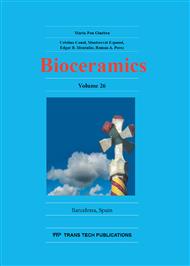[1]
D. Arcos, A.R. Boccaccini, M. Bohner, A. Díez-Pérez, M. Epple, E. Gómez-Barrena, A. Herrera, J.A. Planell, L. Rodríguez-Mañas, M. Vallet-Reg, The relevance of biomaterials to the prevention and treatment of osteoporosis, Acta Biomater. 10 (2014).
DOI: 10.1016/j.actbio.2014.01.004
Google Scholar
[2]
J.A. Buckwalter, M.J. Glimscher, R. R. Cooper, R. Recker, Bone Biology, J Bone Joint Surg Am. 77 (1995) 1256-1275.
DOI: 10.2106/00004623-199508000-00019
Google Scholar
[3]
K. Rezwan, Q.Z. Chen, J.J. Blaker, A. R. Boccaccini, Biodegradable and bioactive porous polymer/inorganic composite scaffolds for bone tissue engineering, Biomaterials. 27 (2006) 3413-3431.
DOI: 10.1016/j.biomaterials.2006.01.039
Google Scholar
[4]
J. R. Porter, T. T. Ruckh, K.C. Popat, Bone Tissue Engineering: A Review in Bone Biomimetics and Drug Delivery Strategies, Biotechnol. Prog. 25 (2009), 1539-1560.
DOI: 10.1002/btpr.246
Google Scholar
[5]
F. Baino, C. Vitale-Brovarone, Three-dimensional glass-derived scaffolds for bone tissue engineering: Current trends and forecasts for the future, J. Biomed. Mater. Res. A. 97A (2011) 514-535.
DOI: 10.1002/jbm.a.33072
Google Scholar
[6]
C. Vitale-Brovarone, F. Baino, E. Verne, High strength bioactive glass-ceramic scaffolds for bone regeneration, J Mater Sci: Mater Med. 20 (2009) 643–653.
DOI: 10.1007/s10856-008-3605-0
Google Scholar
[7]
F. Baino, M. Ferraris, O. Bretcanu, E. Verné, C. Vitale-Brovarone, Optimization of composition, structure and mechanical strength of bioactive 3-D glass-ceramic scaffolds for bone substitution, J. Biomater. Appl. 27 (2013) 872–890.
DOI: 10.1177/0885328211429193
Google Scholar
[8]
C. Renghini, A. Giuliani, S. Mazzoni, F. Brun, E. Larsson, F. Baino, C. Vitale-Brovarone, Microstructural characterization and in vitro bioactivity of porous glass-ceramic scaffolds for bone regeneration by synchrotron radiation X-ray microtomography, J. Eur. Cera. Soc. 33 (2013).
DOI: 10.1016/j.jeurceramsoc.2012.10.016
Google Scholar
[9]
A.M. Ferreira, P. Gentile, S. Sartori 1, C. Pagliano, C. Cabrele, V. Chiono, G. Ciardelli, Biomimetic soluble collagen purified from bones, Biotechnol. J. 7 (2012) 1386–1394.
DOI: 10.1002/biot.201200184
Google Scholar
[10]
S. Sartori, A. Rechichi, G. Vozzi, M. D'Acunto, E. Heine, P. Giusti, G. Ciardelli, Surface modification of a synthetic polyurethane by plasma glow discharge: Preparation and characterization of bioactive monolayers, React. Funct. Polym. 68 (2008).
DOI: 10.1016/j.reactfunctpolym.2007.12.002
Google Scholar
[11]
F. L. Mi, Y. C. Tan, H. F. Liang, H. W. Sung, In vivo biocompatibility and degradability of a novel injectable-chitosan-based implant, Biomaterials 23 (2002) 181–191.
DOI: 10.1016/s0142-9612(01)00094-1
Google Scholar


